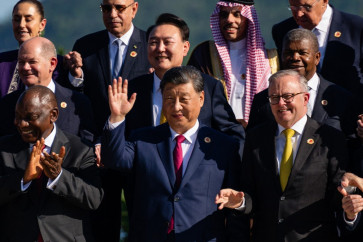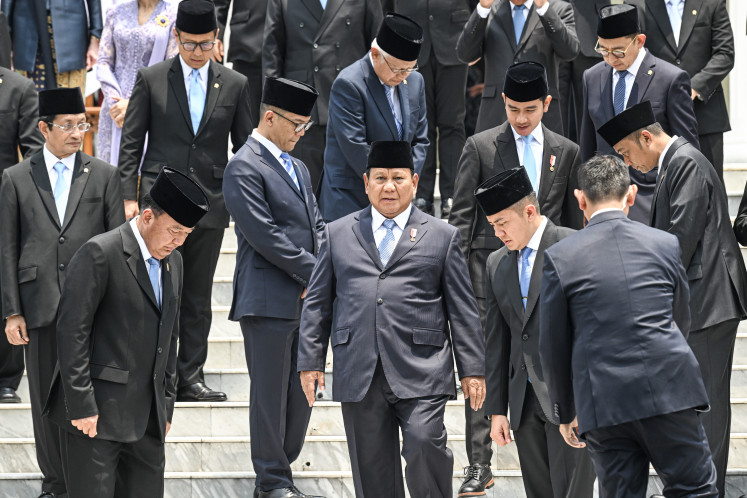Popular Reads
Top Results
Can't find what you're looking for?
View all search resultsPopular Reads
Top Results
Can't find what you're looking for?
View all search resultsArabic loanwords in Indonesian revisited
In various academic articles written about Arabic loanwords in Indonesian and Malay, a variety of arguments have been used about the long and supposedly indirect path these words have apparently followed before ending up in Malay or Indonesian
Change text size
Gift Premium Articles
to Anyone
I
n various academic articles written about Arabic loanwords in Indonesian and Malay, a variety of arguments have been used about the long and supposedly indirect path these words have apparently followed before ending up in Malay or Indonesian.
One of the main problems in studying Arabic loanwords in Indonesian is the fact that some of their original traces may have been erased through the process of language reform of Bahasa Indonesia, part of which has been an artificial process. During this reform, or standardization or codification process, language committees and others have decided what was to be considered as correct and what not.
Also pesantren (Islamic boarding school) must have played an important role, because these schools in particular have trained those in Indonesia who wish to learn Arabic.
As a result, various words have been changed, and various forms have disappeared. Colloquial Arabic elements which were present in various Malay dialects, such as those spoken in Jakarta (Betawi) or elsewhere, have not generally been incorporated into the official Indonesian language.
Arabic loanwords, which may have come to Indonesian through different Nusantara languages from within the archipelago, such as Javanese or Sundanese, or Malay dialects, such as Betawi, have either been transformed into a new classical Arabic jacket, or may have disappeared.
A further study of the path taken by (people carrying) such loanwords still has to be undertaken.
Were they traders? Islamic teachers? Arabs, Persians or others?
If they were Arab traders, it should be logical that the Arabic loanwords in Indonesian or Malay would at least have contained a substantial element of colloquialisms, because traders (just like many other ordinary people) do not generally use classical Arabic when communicating with others in their mother tongue.
As most Arabic loanwords in Indonesian have a classical appearance, it seems reasonable to assume that they reached the Indonesian Archipelago, mainly through people having a written command of Arabic: Islamic teachers and scholars (of Arab, Persian, Indonesian or other origin) at pesantren, in mosques, and elsewhere, and perhaps also through compilers of dictionaries.
But as I shall demonstrate later on, there is also proof of direct face-to-face contact, most probably through Arab traders who used colloquial.
Also the relinquishing of alphabets (including Arabic in an adapted version) in which Malay was originally written, may have led to changes in writing Malay or Indonesian in the Latin alphabet and subsequently in the pronunciation of words, as a result of the transcription decided upon.
As noted, most Arabic loanwords do not bear any colloquial traces which would give a clue as to their regional origin, due to their classical character.
Stuart Campbell, in his article "Indonesian/Malay" (Encyclopedia of Arabic Language and Linguistics), notes on the other hand that "there is no trace of the high frequency and characteristically urban colloquial verbs such as saf and raH, which would indicate a more extensive and systematic evidence of colloquial Arabic influence." (It should be noted, however, that the Arab colloquial shuf does occur in Betawi, but not in official Indonesian).
Concerning Versteegh's remarks on the various pronunciations of jim and qaf, I would have considered it more obvious to look for another, simpler explanation.
In southern parts of the Arabian Peninsula, including Hadramaut in Yemen, from which many Arab immigrants in Indonesia originate, it is quite common to realize jim as gim.
That could, therefore, have been a more probable explanation, the more so as there has hardly been any Egyptian presence in Indonesia. But when looking deeper into this issue, however, it is also very difficult, if not impossible, to find any solid proof of a South Arabian or Hadrami origin.
It should be added that in various other areas of the Arabic speaking world qaf is realized as /g/ (including in Egypt itself, where jim can also be pronounced as jim). But in addition to that, it should be noted that the words used as examples by Versteegh are hardly being used in contemporary Indonesia, if at all. (This is - by the way - not to deny that they could have been used in the past).
The word used normally for camel in Indonesian is unta. (I could not find the word gamal in the dictionaries van Van der Tuuk and Klinkert, which were both compiled in the nineteenth century; but it is mentioned in more recent dictionaries).
The word gereba can be found in the list of Russell Jones, but not in the Kamus Besar Bahasa Indonesia; nor in the (in various ways more extensive) Kamus Lengkap, Indonesia-Inggris of Alan M. Stevens and E. Ed. Schmidgall-Tellings. In Klinkert's Nieuw Maleisch-Nederlandsch Woordenboek it can be found as kirbat (with a dot below the k); gamis is included by Klinkert as kamisa.
Actually, in my opinion, the number of examples provided here is so small (only three, two of which are obsolete or obscure) that it is difficult to convincingly support the thesis that such words must have been passed on to Indonesian through colloquial Arabic, be they from Egyptian, Hadrami or other origin (although it cannot be fully excluded either).
And it should also be noted that in Persian the reflex of the Arabic qaf (?) is not /g/, as mentioned by Versteegh, but ghayn, i.e. written as qaf but pronounced as ghayn (?).
Finally, the influence of Hadrami Arabs on the process of Arabic loanwords in Indonesian should not be overestimated, because larger part of the new generations of the Hadrami community in Indonesia also lost their capability of speaking Arabic as a result of intermarrying with the Indonesian population.
They mostly adopted the languages of their Indonesian mothers. (See also: Natalie Mobini Kesheh, Hadrami Awakening, p.17)
I have not been able to detect any specific Hadrami colloquialisms (yet), although I have detected some colloquial Arabic from the Arabian Peninsula, as I shall show later on.
I would like to explore another method by looking for words which by their structure or vocabulary betray an unmistakable colloquial and, if possible, also regional origin. In modern Indonesian the name for Wednesday (hari Rabu) not only seems to betray a colloquial background, but also a regional one.
In Yemen and parts of Saudi Arabia (however not in Oman) Tuesday and Wednesday are called thaluuth and rabuu'. The latter form may have led to the Indonesian Rabu. (I owe this observation to Dr. Peter Behnstedt). (One might think of al-Yawm al-Rabi' - "the fourth day" - as the origin of Rabu, but this would be illogical, taking the other forms of the weekdays into consideration).
The other weekdays in Indonesian (hari Ahad *Arabic: al-Ahad*, Senin *al-Ithnayn*, Selasa *al-Thalatha'*, Kamis *al-Khamis*, Jumaat *al-Jum'ah*and Sabtu *al-Sabt*) are all close to the classical Arabic forms and do not betray any dialect influence with the exception of Senin, which, different from Rabu, has no clear regional origin. The alternative form Isnin, also found in vari ous dictionaries, is closer to classical Arabic (Yawm al-Ithnayn).










